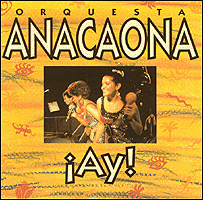Women music in Cuba
- Submitted by: admin
- Arts and Culture
- Music
- 06 / 09 / 2007

Women orchestras fill an exciting chapter in the history of Cuban music. Women gave to the Cuban night life a touch of distinction in the parties, dances, and concerts, especially in the Aires Libres of Prado and in the marquee of Saratoga Hotel which was restored and anxiously waits for the presentation of female groups.
Irene Herrera Laferté, timbal player and director founder of the Charanga Doña Irene, is considered the pioneer of the feminine groups of Cuba. She was born in Havana on October 20, 1877 and died in 1970 with 93 years. As it happens this year will be the 130th anniversary of her birth. Women orchestras fill an interesting chapter in the history of Cuban music of the XX century. Now that Las Anacaonas reach their 75th anniversary, we will look back on these groups of women so attractive in the music panorama.
History goes back long before 1932 when Las Anacaonas first appeared. Before this we must go"according to Luis Rovira"to the history of a lady whose last names were Herrera Laferté and whom around that time was called The Virtuous of the Kettledrums, Doña Irene who played several instruments: harmonic, lute, and accordion. It is said that in late XIX century, in the middle of the war for independence, she encouraged mambi soldiers singing the National Anthem, danzón and mazurkas.
Then, in 1928 "next year will be commemorated the 80th anniversary" she organizes with her daughters a quintet named La Charanga. Those were the times in which danzón singers were abundant in the city playing the rhythm in fashion encouraged by Miguel Faílde, magnified by Antonio María Romeu and a group of creative charanga players.
Four years later, in 1932 "75 years ago" Las Anacaonas appeared; they opened the path for women sextets. Then women groups were the boom; I think that fashion was related with Machado dictatorship which underwent the international economic crisis. The crises thrust generations to change the rules and customs in the search of survival. Lets don't forget that back then women didn't go out alone, much less to musical activities. It was María Teresa Vera, the troubadour who left the platoon behind and broke all conventional norms of the time.
Hence appear the Edén Habanero, Trovadoras del Cayo "famous for the presence of Isolina Carrillo, the author of Dos Gadenias (Two Gardenias)", Renovación Social, Las Hermanas Álvarez, Ensueño, Las Hermanas Mesquiada "where Leo Brouwer's mother played, Mercy Mesquiada.
Alicia Valdes reminds us that also appeared women group with a smaller format as the duet Las Hermanas Marti, the trio Las Hermanas Lago (in some moments they were a quartet). And other groups like Las Hermanas Patterson, the quartet Las Hermanas Valdivia; in 1952 Las D'Aida.
The great boom was reached in the 90s. Three aspects coincide for thrust forward that boom: Its the time with the greatest amount of music schools and students in the country. The resonance of Cuban salsa soars and all the musicians recognize the importance of dancing Cuban music abroad. Lastly, the economic crisis the country undergoes as a consequence of the fall of the socialist field in East Europe.
When female groups reappeared in the end of the millennium, Las Anacaonas are the first ones. Since the 80s, a series of graduate students of Amadeo Roldán Conservatory were invited by the founders to integrate Las Anacaonas. In 1987, after the physical disappearance of old members and the retirement of others, Georgia Aguirre becomes the director whom next to her sister Dorita, continues the work of the orchestra.
The first Anacaonas made international tours since 1936, when they traveled to up to 30 countries. Starting in 1998, the following girls began a much more active tour in Europe, Asia, and America. In 1999, after 61 years of the first performance in New York, the orchestra repeats its visit. This time with a special ingredient, the new members met one of the founders, Graciela Perez who resides since 1943 in the city of sky-scrapers.
Other women groups that soars towards the sky in last decade were: Son las que son, Danzonellas, Son Damas, Damas del Caribe, Flores Sonoras, Cafe, Azucar, Chicas de Seda (of Luis Dominguez and Don Amador), Trio Batiyé, Ricachá, Caramelo Son, Yamila y su Charanga, Las Canelas. In other provinces: Almendra (Pinar del Rio), Voces (Matanzas), Vida (Villa Clara), Las Cubanitas (Camaguey), Indiana (Santiago de Cuba), Ad Libitum (Cienfuegos).
Theres a debate on the musical strength of women groups most certainly the eminently strong music, with timba, is the one made by men. Not even most of the men are ready to stand out in Rumba groups; lets just say that the Cuban timba hasnt been complete mastered abroad, its a very volatile music" just like gasoline.
Still what is missing in one band is truly to spare in another one. Female groups have a particular charm, closely related with the dancing show which always fascinates spectators. Women orchestras gave a magic touch to the boom of Cuban salsa, a history that is not over yet and many things have been written about it.
Source: By Rafael Lam, CubaSi
Comments